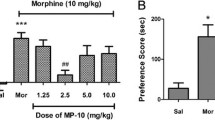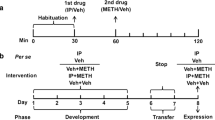Abstract
Methamphetamine (METH), the most widely distributed psychostimulant, aberrantly activates the reward system in the brain to induce addictive behaviors. The presynaptic protein “Piccolo”, encoded by Pclo, was identified as a METH-responsive protein with enhanced expression in the nucleus accumbens (NAc) in mice. Although the physiological and pathological significance of Piccolo has been identified in dopaminergic signaling, its role in METH-induced behavioral abnormalities and the underlying mechanisms remain unclear. To clarify such functions, mice with Piccolo knockdown in the NAc (NAc-miPiccolo mice) by local injection of an adeno-associated virus vector carrying miRNA targeting Pclo were generated and investigated. NAc-miPiccolo mice exhibited suppressed hyperlocomotion, sensitization, and conditioned place preference behavior induced by systemic administration of METH. The excessive release of dopamine in the NAc was reduced in NAc-miPiccolo mice at baseline and in response to METH. These results suggest that Piccolo in the NAc is involved in METH-induced behavioral alterations and is a candidate therapeutic target for the treatment of drug addiction.



Similar content being viewed by others
Data Availability
The data presented in this manuscript are available from the corresponding authors on reasonable request.
References
Chomchai C, Chomchai S (2015) Global patterns of methamphetamine use. Curr Opin Psychiatry 28:269–274. https://doi.org/10.1097/yco.0000000000000168
Rolls ET (2000) The orbitofrontal cortex and reward. Cereb Cortex 10:284–294. https://doi.org/10.1093/cercor/10.3.284
Russo SJ, Nestler EJ (2013) The brain reward circuitry in mood disorders. Nat Rev Neurosci 14:609–625. https://doi.org/10.1038/nrn3381
Seiden LS, Sabol KE, Ricaurte GA (1993) Amphetamine: effects on catecholamine systems and behavior. Annu Rev Pharmacol Toxicol 32:639–677. https://doi.org/10.1146/annurev.pa.33.040193.003231
Gu SM, Cha HJ, Seo SW, Hong JT, Yun J (2020) Dopamine D1 receptor antagonist reduces stimulant-induced conditioned place preferences and dopamine receptor supersensitivity. Naunyn Schmiedebergs Arch Pharmacol 393:131–138. https://doi.org/10.1007/s00210-019-01694-3
Koob G (1992) (1992) Drugs of abuse: anatomy, pharmacology and function of reward pathways. Trends Pharmacol Sci 13:177–184. https://doi.org/10.1016/0165-6147(92)90060-j
Beier KT, Steinberg EE, DeLoach KE, **. Cell 162:622–634. https://doi.org/10.1016/j.cell.2015.07.015
Niwa M, Nitta A, Mizoguchi H, Ito Y, Noda Y, Nagai T, Nabeshima T (2007) A novel molecule “shati” is involved in methamphetamine-induced hyperlocomotion, sensitization, and conditioned place preference. J Neurosci 27:7604–7615. https://doi.org/10.1523/jneurosci.1575-07.2007
Sumi K, Uno K, Noike H, Tomohiro T, Hatanaka Y, Furukawa-Hibi Y, Nabeshima T, Miyamoto Y, Nitta A (2017) Behavioral impairment in SHATI/NAT8L knockout mice via dysfunction of myelination development. Sci Rep 7:16872. https://doi.org/10.1038/s41598-017-17151-1
Miyanishi H, Muramatsu SI, Nitta A (2021) Striatal Shati/Nat8l-BDNF pathways determine the sensitivity to social defeat stress in mice through epigenetic regulation. Neuropsychopharmacology 46:1594–1605. https://doi.org/10.1038/s41386-021-01033-2
Cen X, Nitta A, Ibi D, Zhao Y, Niwa M, Taguchi K, Hamada M, Ito Y, Ito Y, Wang L, Nabeshima T (2008) Identification of Piccolo as a regulator of behavioral plasticity and dopamine transporter internalization. Mol Psychiatry 13:451–463. https://doi.org/10.1038/sj.mp.4002132
Nitta A, Izuo N, Hamatani K, Inagaki R, Kusui Y, Fu K, Asano T, Torii Y, Habuchi C, Sekiguchi H, Iritani S, Muramatsu SI, Ozaki N, Miyamoto Y (2021) Schizophrenia-like behavioral impairments in mice with suppressed expression of piccolo in the medial prefrontal cortex. J Pers Med 11:607. https://doi.org/10.3390/jpm11070607
Fu K, Miyamoto Y, Otake K, Sumi K, Saika E, Matsumura S, Sato N, Ueno Y, Seo S, Uno K, Muramatsu SI, Nitta A (2017) Involvement of the accumbal osteopontin-interacting transmembrane protein 168 in methamphetamine-induced place preference and hyperlocomotion in mice. Sci Rep 7:13084. https://doi.org/10.1038/s41598-017-13289-0
Fu K, Miyamoto Y, Sumi K, Saika E, Muramatsu SI, Uno K, Nitta A (2017) Overexpression of transmembrane protein 168 in the mouse nucleus accumbens induces anxiety and sensorimotor gating deficit. PLoS ONE 12:e0189006. https://doi.org/10.1371/journal.pone.0189006
Fenster S, Chung W, Zhai R, Cases-Langhoff C, Voss B, Garner A, Kaempf U, Kindler S, Gundelfinger E, Garner C (2000) Piccolo, a presynaptic zinc finger protein structurally related to Bassoon. Neuron 25:203–214. https://doi.org/10.1371/journal.pone.0189006
Bochdanovits Z, Verhage M, Smit A, Geus E, Posthuma D, Boomsma D, Penninx B, Hoogendijk W, Heutink P (2009) Joint reanalysis of 29 correlated SNPs supports the role of PCLO/Piccolo as a causal risk factor for major depressive disorder. Mol Psychiatry 14:650–652. https://doi.org/10.1038/mp.2009.37
Choi K, Higgs B, Wendland J, Song J, McMahon F, Webster M (2011) Gene expression and genetic variation data implicate PCLO in bipolar disorder. Biol Psychiat 69:353–359. https://doi.org/10.1016/j.biopsych.2010.09.042
Seo S, Takayama K, Uno K, Ohi K, Hashimoto R, Nishizawa D, Ikeda K, Ozaki N, Nabeshima T, Miyamoto Y, Nitta A (2013) Functional analysis of deep intronic SNP rs13438494 in intron 24 of PCLO gene. PLoS ONE 8:e76960. https://doi.org/10.1371/journal.pone.0076960
Uno K, Nishizawa D, Seo S, Takayama K, Matsumura S, Saika N, Ohi K, Nabeshima T, Hashimoto R, Ozaki N, Hasegawa J, Sato N, Tanioka F, Sugimura H, Fukuda K, Higuchi S, Ujike IT, Iwata N, Sora I, Iyo M, Kondo N, Won MJ, Naruse N, Uehara-Aoyama K, Itokawa M, Yamada M, Ikeda K, Miyamoto Y, Nitta A (2015) The Piccolo intronic single nucleotide polymorphism rs13438494 regulates Dopamine and Serotonin uptake and shows associations with dependence-like behavior in genomic association study. Curr Mol Med 15:265–274. https://doi.org/10.2174/1566524015666150330145722
Sullivan PF, de Geus EJ, Willemsen G, James MR, Smit JH, Zandbelt T, Arolt V, Baune BT, Blackwood D, Cichon S, Coventry WL, Domschke K, Farmer A, Fava M, Gordon SD, He Q, Heath AC, Heutink P, Holsboer F, Hoogendijk WJ, Hottenga JJ, Hu Y, Kohli M, Lin D, Lucae S, Macintyre DJ, Maier W, McGhee KA, McGuffin P, Montgomery GW, Muir WJ, Nolen WA, Nöthen MM, Perlis RH, Pirlo K, Posthuma D, Rietschel M, Rizzu P, Schosser A, Smit AB, Smoller JW, Tzeng JY, van Dyck R, Verhage M, Zitman FG, Martin NG, Wray NR, Boomsma DI, Penninx BW (2009) Genome-wide association for major depressive disorder: a possible role for the presynaptic protein piccolo. Mol Psychiatry 14:359–375. https://doi.org/10.1038/mp.2008.125
Falck J, Bruns C, Hoffmann-Conaway S, Straub I, Plautz EJ, Orlando M, Munawar H, Rivalan M, Winter Y, Izsvák Z, Schmitz D, Hamra FK, Hallermann S, Garner CC, Ackermann F (2020) Loss of Piccolo function in rats induces cerebellar network dysfunction and pontocerebellar hypoplasia type 3-like phenotypes. J Neurosci 40:2943–2959. https://doi.org/10.1523/jneurosci.2316-19.2020
Krzyzosiak A, Szyszka-Niagolov M, Wietrzych M, Gobaille S, Muramatsu S, Krezel W (2010) Retinoid x receptor gamma control of affective behaviors involves dopaminergic signaling in mice. Neuron 66:908–920. https://doi.org/10.1016/j.neuron.2010.05.004
Izuo N, Kasahara C, Murakami K, Kume T, Maeda M, Irie K, Yokote K, Shimizu T (2017) A Toxic Conformer of Aβ42 with a Turn at 22–23 is a novel therapeutic target for alzheimer’s disease. Sci Rep 7:11811. https://doi.org/10.1038/s41598-017-11671-6
Miyamoto Y, Ishikawa Y, Iegaki N, Sumi K, Fu K, Sato K, Furukawa-Hibi Y, Muramatsu S, Nabeshima T, Uno K, Nitta A (2014) Overexpression of Shati/Nat8l, an N-acetyltransferase, in the nucleus accumbens attenuates the response to methamphetamine via activation of group II mGluRs in mice. Int J Neuropsychopharmacol 17:1283–1294. https://doi.org/10.1017/s146114571400011x
Haddar M, Uno K, Azuma K, Muramatsu SI, Nitta A (2020) Inhibitory effects of Shati/Nat8l overexpression in the medial prefrontal cortex on methamphetamine-induced conditioned place preference in mice. Addict Biol 25:e12749. https://doi.org/10.1111/adb.12749
Lucot JB, Wagner GC, Schuster CR, Seiden LS (1980) The effects of dopaminergic agents on the locomotor activity of rats after high dose of methylamphetamine. Pharmacol Biochem Behav 13:409–413. https://doi.org/10.1016/0091-3057(80)90247-6
Tsai HC, Zhang F, Adamantidis A, Stuber GD, Bonci A, de Lecea L, Deisseroth K (2009) Phasic firing in dopaminergic neurons is sufficient for behavioral conditioning. Science 324:1080–1084. https://doi.org/10.1126/science.1168878
Chiara GD, Imperato A (1988) Drugs abused by humans preferentially increase synaptic dopamine concentrations in the mesolimbic system of freely moving rats. Proc Natl Acad Sci U S A 85:5274–5278. https://doi.org/10.1073/pnas.85.14.5274
Abekawa T, Ohmori T, Koyama T (1994) Effects of repeated administration of a high dose of methamphetamine on dopamine and glutamate release in rat striatum and nucleus accumbens. Brain Res 643:276–281. https://doi.org/10.1016/0006-8993(94)90033-7
Hongbin Y, de Jong JW, YeEun T, James P, Bateup HS, Stephan L (2018) Nucleus accumbens subnuclei regulate motivated behavior via direct inhibition and disinhibition of VTA dopamine subpopulations. Neuron 97:434–449. https://doi.org/10.1016/j.neuron.2017.12.022
Kai N, Nishizawa K, Tsutsui Y, Ueda S, Kobayashi K (2015) Differential roles of dopamine D1 and D2 receptor-containing neurons of the nucleus accumbens shell in behavioral sensitization. J Neurochem 135:1232–1241. https://doi.org/10.1111/jnc.13380
Mishima T, Fujiwara T, Sanada M, Kofuji T, Kanai-Azuma M, Akagawa K (2014) Syntaxin 1B, but not syntaxin 1A, is necessary for the regulation of synaptic vesicle exocytosis and of the readily releasable pool at central synapses. PLoS ONE 9:e90004. https://doi.org/10.1371/journal.pone.0090004
Fujiwara T, Kofuji T, Mishima T, Akagawa K (2017) Syntaxin 1B contributes to regulation of the dopaminergic system through GABA transmission in the CNS. Eur J Neurosci 46:2867–2874. https://doi.org/10.1111/ejn.13779
Acknowledgements
We thank Naomi Takino and Mika Ito for their technical assistance in producing the AAV vectors.
Funding
This research was supported by a Grant-in-Aid for Scientific Research (KAKENHI) (B) [JSPS KAKENHI Grant Number, 26293213, JP21H02632] (SM, AN), Kobayashi Foundation (AN), AdAMS (Ac210045, AN), Smoking Research Foundation Grant for Biomedical Research and Foundation (AN), JST SPRING, Grant Number JPMJSP2145 (YK). The funders had no role in the study design, data collection or analysis, decision to publish, or manuscript preparation.
Author information
Authors and Affiliations
Contributions
Y. K., K.U., B.G. and A.N. were responsible for study concept and design. Y.K. and K.U. contributed to the acquisition of data for behavioral experiments, in vivo microdialysis, and neurotransmitter content. S.M. designed and produced the AAV vectors. Y.K. and N.I. analyzed the data and interpreted the findings. Y.K. and N.I. drafted the manuscript. A.N. critically revised the manuscript for intellectual content. All the authors reviewed the content and approved the final version for publication.
Corresponding author
Ethics declarations
Competing interest
SM has equity in the Gene Therapy Research Institution, Co., Ltd., which commercializes the use of AAV vectors for gene therapy applications. To the extent that the work in this manuscript increases the value of these commercial holdings, SM has conflicts of interest. The other authors have no relevant financial or non-financial interests to disclose.
Ethical Approval
All animal experiments followed the National Institutes of Health Guidelines for the Care and Use of Laboratory Animals. Animal experimental protocols were approved by the Animal Care and Use Committee of the University of Toyama (Approval number: A2018PHA-13) and conducted in accordance with Institutional Animal Experiment Handling Rules of the University of Toyama. All procedures related to genetic modification followed the Guideline for Recombinant DNA Experiments from the Ministry of Education, Culture, Sports, Science and Technology, Japan, and were approved by the Gene Recombination Experiment Safety Committee of the University of Toyama (Approval number: G2015PHA-14).
Additional information
Publisher's Note
Springer Nature remains neutral with regard to jurisdictional claims in published maps and institutional affiliations.
Rights and permissions
Springer Nature or its licensor holds exclusive rights to this article under a publishing agreement with the author(s) or other rightsholder(s); author self-archiving of the accepted manuscript version of this article is solely governed by the terms of such publishing agreement and applicable law.
About this article
Cite this article
Kusui, Y., Izuo, N., Uno, K. et al. Knockdown of Piccolo in the Nucleus Accumbens Suppresses Methamphetamine-Induced Hyperlocomotion and Conditioned Place Preference in Mice. Neurochem Res 47, 2856–2864 (2022). https://doi.org/10.1007/s11064-022-03680-3
Received:
Revised:
Accepted:
Published:
Issue Date:
DOI: https://doi.org/10.1007/s11064-022-03680-3




